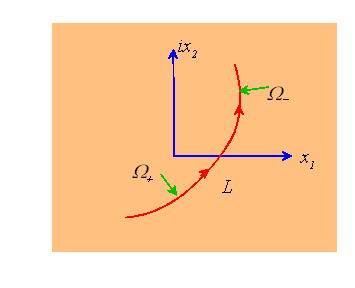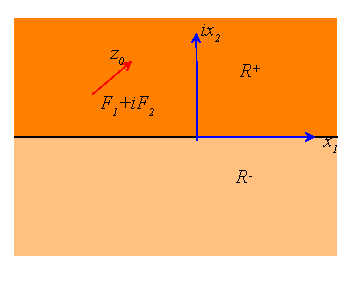 EN224: Linear
Elasticity
EN224: Linear
Elasticity 
Division of Engineering
Application of Analytic Continuation: Traction Boundary Value Problems for the Half-Plane
We now return to the traction boundary value problem we posed earlier. Find the displacements and stresses in a half-space due to a prescribed distribution of traction on its surface.
We will use the representation based on stress continuation to derive
our result. Evidently, we need to find a potential![]() which is analytic
in both R+ and R-, and satisfies
which is analytic
in both R+ and R-, and satisfies

(we assumed that
here, which can only be verified after we have a solution).
Thus, we need to find a potential with a prescribed discontinuity on the real line.
It looks like we are stumped here, but actually this problem has a well-known solution.
To solve the problem, we make use of the Plemelj formulae, for which we will need some more results from the general theory of complex variables.
The Plemelj formulae
Let![]() be a complex valued function defined on an arc L.
Assume that
be a complex valued function defined on an arc L.
Assume that![]() satisfies the Holder conditions on L, that is:
satisfies the Holder conditions on L, that is:
for any two points ![]() , where A is a positive constant
and
, where A is a positive constant
and![]()

Then

is sectionally analytic in a region R cut along L; that
is to say,![]() satisfies the following conditions:
satisfies the following conditions:
(1)![]() is analytic on {R-L}
is analytic on {R-L}
![]() (2)
(2) ![]() is sectionally continuous in the neighborhood of L
is sectionally continuous in the neighborhood of L
(3) At an end![]() of the arc L,
of the arc L,
![]() satisfies
satisfies![]()
Furthermore, the limiting values![]() may be shown to exist on
L and satisfy
may be shown to exist on
L and satisfy

Where PV denotes that the integral should be interpreted as a Cauchy Principal Value (the integral is singular because z0 lies on L). These two equations are the Plemelj formulae. For a proof of these results, you could consult Muskhelishvili `Singular Integral Equations,’ Dover reprint.
These results provide the key to solving the half-plane problem. The most general solution satisfying our boundary condition is

We added the polynomial here because any continuous analytic function
on R evidently generates zero traction on the surface. If the stresses
vanish at infinity then ![]() .
.
Example: Determine the potentials generating displacement and stress fields in a half-plane loaded by uniform pressure p and shear s on the region –a<x1<a.
Evidently

And hence
Displacement and stress fields may be then determined from

Example: Fields induced by point forces beneath the surface of a half-plane.
Here is another useful trick which exploits the idea of analytic continuation.

A half-plane with traction free surface is subjected to a point force
![]() acting at a point
acting at a point ![]() . Determine complex potentials
for this problem.
. Determine complex potentials
for this problem.
Recall that the potentials

ogether with the standard complex variable formulation (no continuation, that is to say) generated the fields associated with a point force acting at z0 in an infinite solid.
On the real line, these forces induce stresses
We must therefore superpose an additional solution ![]() which generates
equal and opposite tractions on the surface of the half-plane. We could
apply the procedure outlined in the preceding subsection to do this, but
it is quicker to get the solution directly. Suppose that the corrective
solution is to be generated by a potential , using the stress continuation
discussed earlier. Then
which generates
equal and opposite tractions on the surface of the half-plane. We could
apply the procedure outlined in the preceding subsection to do this, but
it is quicker to get the solution directly. Suppose that the corrective
solution is to be generated by a potential , using the stress continuation
discussed earlier. Then
Now, observe that ![]() is analytic in R-, while
is analytic in R-, while![]() is analytic
in R+.
is analytic
in R+.
We may therefore satisfy the boundary conditions by setting

This solves our problem, but it is inconvenient to have part of the
solution expressed using the standard complex variable representation,
while the corrective term is expressed using the formulation based on stress
continuation across the real axis. We can write the correction in the standard
form by computing![]() . Recall that
. Recall that
so that
(Note that whenever we evaluate![]() we need to decide whether
its argument lies in R+ or R-. Since z lies in R+,
we need to decide whether
its argument lies in R+ or R-. Since z lies in R+,![]() is in R-. )
is in R-. )
Then, finally, we may write
giving

Stresses and displacements should be evaluated using the standard representation

ensuring that both z and z0 are in R+
Exactly the same approach may be used to find the fields due to a dislocation near a free surface. Alternatively, using displacement continuation, we may compute the fields due to a dislocation near a rigid boundary.